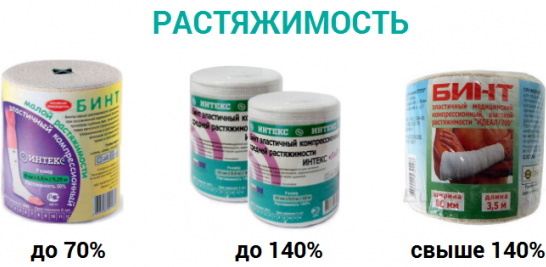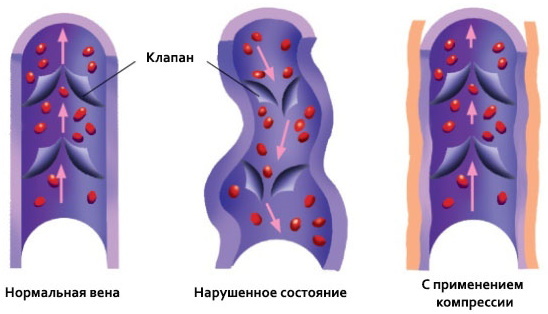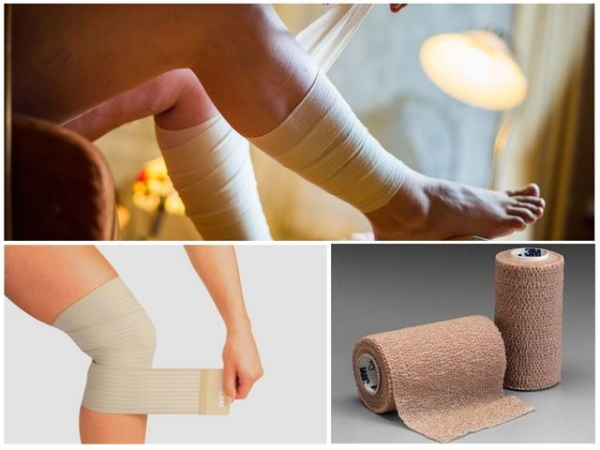Content
- Types of elastic bandages
- Bandage sizes
- Contraindications for use
- Principle of operation and recommendations
- How to apply a bandage correctly
- After operation
- With varicose veins
- With thrombosis
- With edema
- General tips for using bandages
- How much to wear an elastic bandage and when to change it
- Elastic bandage video
Leg bandaging is used in medicine not only for the treatment of sports injuries, but also as part of complex therapy for violations of the activity of organs or systems. Elastic bandages are used in medicine in the recovery period after surgery or for vascular diseases of the lower extremities.
Types of elastic bandages
Elastic bandages are made from the following materials:
| Material type | Peculiarities |
| Cotton | It is based on cotton fiber, to which nylon and polyester threads are added. Such bandages are durable, do not lose their shape for a long time, they can be machine washed. The length can be adjusted by cutting the free edge, so that after cutting the threads will not crumble. |
| Cotton - synthetic | The bandages are based on cotton and nylon threads in equal amounts. After adjusting the length, you need to overcast the edge to avoid shedding the fibers. Partial deformation occurs after 5-7 washes. |
| Synthetic | Fully synthetic products made from rubber or polyurethane. They are not able to pass air, they are deformed after the first wash. Most often, these bandages are intended for single use. |

According to the degree of stretching of elastic fibers, bandages are divided into the following categories:
- short stretch bandages when stretching, the length increases by 45-65%, they are used in case of impaired venous circulation or impaired lymph outflow);
- bandages with medium stretch (when stretched, the length increases by 110-145%, used after compression sclerotherapy);
-
high elongation bandages (the length increases by 150-170%, is used in the treatment of chronic vascular diseases of the lower extremities outside the stage of exacerbation).

Depending on the shape, 2 groups of compression material are distinguished:
- tape - long elastic bands made of interwoven synthetic and natural fibers, which require certain skills and abilities to use;
- tubular - seamless bandages of various sizes that do not require special knowledge in use.
Bandage sizes
In order not to have to independently adjust the bandage to the desired length, you must immediately purchase the product of the required size.
Elastic bandages are divided into 5 groups according to their length:
- very short (length 1 - 1.5 m) suitable for fixing the wrist joint;
- short (length 1.5 - 2 m) are used to fix the ankle;
- medium (length 2-3 m) are used for injuries of the knee and elbow joints;
- long (3-4 m) are necessary to fix the entire upper limb with the capture of several joints;
- the maximum length (is 5 m) is applied to the entire lower limb.
The width of the elastic bandage varies from 3 to 12 cm.
Contraindications for use
Bandaging the legs with an elastic bandage is not a harmless procedure and is contraindicated in the following conditions:
- heart failure of the right ventricular type: an elastic bandage narrows the lumen of a blood vessel, contractile the muscle's ability is not enough to push the blood in the right volume, tissue starvation and deterioration of the general states;
- violation of the integrity of the skin in the area of application of the bandage: material applied to the damaged skin, will not only block the access of oxygen necessary to enhance the regeneration processes, but will also increase irritation;
- skin diseases in the area of bandage application;
- diabetic foot syndrome (a late complication of diabetes mellitus, manifested by purulent-necrotic tissue lesions and osteoarticular lesions);
- obliterating vascular lesions (narrowing of the lumen of blood vessels and a violation of their blood filling).
Principle of operation and recommendations
The work of elastic bandages is based on the contractile ability of the threads, which are pulled together after application and fix the required area. In addition to giving a clear position to the ligaments and joints, tissues do not allow the walls of blood vessels to expand excessively and increase their tone, which is necessary for normal blood circulation.
When choosing and buying a compression material, you need to pay attention to one parameter - the change in the width of the tape when stretched. If the width of the tissue changes after stretching in the hands, it means that this product is of poor quality and when applied as a bandage, the desired compression or fixing effect will not be achieved.
To fix the area of the ankle or knee joint, a bandage no more than 2 m long is required.To apply a compression bandage over the entire surface of the leg, a bandage no shorter than 3 m is needed.
The best option for any indication for bandaging are bandages made of natural cotton fabric. They do not cause an allergic reaction, do not require special care, and are easy to wash.
General recommendations when applying an elastic bandage to the lower limb:
- the bandage should correspond to the area of application and the nature of the damage in length and extensibility;
- do not bandage a swollen leg;
- it is best to apply a bandage in the morning after waking up, without getting out of bed, while the leg should be in an elevated position;
- the direction of bandaging must be carried out from the narrow part of the leg to the wide one;
- all folds of the fabric should be straightened;
- the trajectory of hand movement when applying a bandage should look like this: from left to right, from bottom to top relative to the body - this will exclude venous congestion in the leg;
- each next layer covers the previous one by 1/3 of the bandage width;
- the correctness of the application is determined by the cyanosis test: if after 20 minutes. the blue from the toes has disappeared, which means that the bandage was applied correctly, if the cyanosis has not disappeared or has intensified, you need to remove the bandage and apply it correctly;
- you cannot wear a bandage all the time.
How to apply a bandage correctly
An elastic bandage must perform the functions assigned to it, therefore, it is necessary to observe the technique of performing the manipulation of bandaging the legs. Its violation can not only make the imposition of a bandage senseless, but also harm health.
An elastic bandage is applied to the leg using the following technique:
- It is necessary to apply a bandage in the morning immediately after waking up, without getting out of bed.
- The leg should be in an elevated position.
- If the vessels are fragile, place a softening material under the bandage.
- The first round is applied to the ankle joint, then the bandage is lowered onto the foot in the area under the toe pads with the heel gripped in and wrapped around the foot.
- Along the front of the leg, the bandage rises to the ankle area and wraps around the joint, then passes to the foot and makes a turn, capturing a third of the previous round. This step is repeated 3-4 times until the foot is completely covered with the material.
- In even turns, the bandage is lifted up the leg using the herringbone technique to the groin fold in order to avoid tissue slipping.
- The last round completely covers the underlying one. Fixation is done using a hook that comes with the bandage.
After operation
In the early postoperative period, an elastic bandage is used for the following purposes:
- prevention of thromboembolism - the formation of blood clots from blood clots and their blockage of the lumen of large vessels;
- improved blood circulation in the lower limb;
- reducing the risk of trophic ulcers.
The duration of wearing the compression material is determined by the doctor. During surgery, the bandage is applied to the vessels for 3-5 days without being removed at night. The change takes place once a day, in the morning after waking up. For the next 2-3 weeks, the bandage is applied daily, but removed during a night's sleep.
In operations on the joints, the bandage is applied for 5-6 days. It is permissible to give the leg a rest 2 times a day for 20-30 minutes, while the limb should be at rest. Then the elastic bandage is replaced with an orthosis.
With varicose veins
Bandaging the legs with an elastic bandage for varicose veins of the lower extremities helps to maintain the tone of the vascular walls.
If trophic ulcers are present on the skin, before applying the compression material, they are thoroughly treated by washing and applying an alginate bandage. If the ulcers become wet, an additional absorbent layer is applied, such as a commercially produced super absorbent dressing.
In some cases, a combined bandage is used using two or three bandages of varying degrees of stretching. The bandage must be worn without removing it from morning until bedtime.
With thrombosis
The imposition of compression hosiery for venous thrombosis of the lower extremities improves the outflow of venous blood, reduces the risk of edema, and enhances the tone of the vascular walls. Slightly tighter tours should be done in the area of the knee joint so that the compression load is uniform over the entire length of the leg.
With edema
Bandaging the legs with an elastic bandage is performed for edema of any origin - traumatic, in violation of the work of the heart muscle, in case of renal lesions. If the edema is provoked by organ dysfunction or varicose veins, the compression material is applied over the entire length of the leg.
If the swelling is caused by a joint injury, the bandage is applied only to the affected area.
In case of knee injury, leg bandaging is performed in a converging way:
- 2 rounds of bandage are applied below the damaged joint.
- The same 2 rounds are applied above the knee.
- The upper and lower rounds are applied alternately until the joint is completely closed. The bandage is fixed with a pin included in the kit.
You can check the correct application of the bandage using the extension test - it should be performed in full, but with great physical effort.
General tips for using bandages
The service life of the compression material depends on the intensity of use and compliance with the rules of care. In accordance with the rules of hygiene, the product should be washed once every 7-10 days or as it gets dirty. In order to quickly change the bandage, if necessary, it is recommended to purchase at once 2-3 bandages of the required length and degree of stretching. Both hand and machine wash without automatic spinning is allowed. You need to squeeze the fabric with your hands, without stretching or twisting the compression material.
Dry elastic bandages in terry or cotton cloth, which will absorb excess moisture. Do not broadcast raw material in an upright position, this will increase the tension of the elastic threads. Drying on a battery or electric heaters can dry out the elastic fibers and lose the compressive properties of the fabric.
How much to wear an elastic bandage and when to change it
The period of wearing an elastic bandage is determined by the doctor, taking into account the disease and the characteristics of the course. After surgical interventions on the vessels, wearing a compression material is prescribed for 3-4 weeks. For joint surgery, the maximum period of bandaging is 7 days.
When the ligaments are sprained, the duration of wearing a compression bandage depends on the severity: with a slight sprain, bandaging it takes 4-7 days, for more serious injuries it is recommended to use compression products for 2-3 months or for the entire period recovery.
With varicose veins of the lower extremities, compression techniques are mandatory included in the complex conservative treatment or are recommended for use for the entire period of preparation for surgery on vascular walls. The bandage is applied in the morning and removed at night's sleep.
You need to change the bandage in several cases:
- a compression material of a different degree of elongation is required;
- the bandage has lost its shape and does not perform a fixing function;
- large amounts of burst elastic fibers are visible on the fabric.
Bandaging the legs with compression materials is used for pathological conditions such as thrombophlebitis, varicose veins vascular disease of the lower extremities, with injuries of a sports and domestic nature, as well as in the early postoperative period. To achieve a compression effect, it is necessary to choose elastic bandages of the appropriate length and degree of elongation, as well as observe the rules for applying a compression bandage.
Elastic bandage video
Tight elastic bandage. What for:



